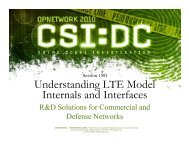Understanding TCP/IP Model Internals and Interfaces
Understanding TCP/IP Model Internals and Interfaces
Understanding TCP/IP Model Internals and Interfaces
You also want an ePaper? Increase the reach of your titles
YUMPU automatically turns print PDFs into web optimized ePapers that Google loves.
1508 <strong>Underst<strong>and</strong>ing</strong> <strong>TCP</strong>/<strong>IP</strong> <strong>Model</strong> <strong>Internals</strong> <strong>and</strong> <strong>Interfaces</strong><br />
3. Set a trace on <strong>TCP</strong><br />
a. To set a trace on <strong>TCP</strong>, type ltrace tcp in the ODB prompt as shown on the above picture <strong>and</strong><br />
press Enter.<br />
b. To continue the simulation, click on the Continue button.<br />
c. The simulation now continues <strong>and</strong> prints <strong>TCP</strong>-related information.<br />
4. Examine the 3-way h<strong>and</strong>shake. First, scroll up to the first event that gets printed. You can see<br />
that the server opens a connection at time 0.<br />
• Is this a passive or active connection? How do you know? _________________<br />
CONFIDENTIAL – RESTRICTED ACCESS: This information may not be disclosed, copied, or transmitted in any format without the prior written consent of OPNET Technologies, Inc.<br />
© 2010 OPNET Technologies, Inc.<br />
4
















